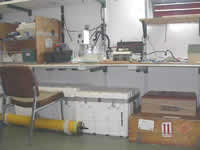| |
| |

The wet lab is battened-down and ready
for the frequent rolls and
pitches associated with the oceans motions.

Up high on the ships mast are a
couple of anemometers (at the ends of the array of instruments) used
to determine wind speed. These have an attached wind vane that give
the wind direction.
|
|
Teacher Logbook - R/V Wecoma
Missy
Holzer 's Sealog:
CTD Cruise Day 14
Weather at 1630 hours PDT:
Weather at 1630 hours PST: Cloudy skies with
winds of 23 knots from the
northwest, and visibility of 12 miles. Barometric pressure is 1016.6,
and
the temperature is 59 degrees Fahrenheit. Ocean swells are 8 feet out
of
the northwest, and the seas are 4 feet out of the northwest.
Duck! Hold onto
your seat! Keep both feet on the ground at the same time! No fancy footwork
when the ship is rolling and pitching in high seas! Warnings sometimes aren't
enough to keep yourself from moving in a direction contrary to your desired
motion. Unless you're out here or have been on a Tilt-a-Whirl at the carnival
for 12 hours, it's tough to get a true sense of what really happens when
the ocean is in motion. Those "sea stories" that all the science
staff and crew relate are merely stories unless you've seen a wave crash
into one side of the ship and make it all the way over to the other. Battening
down the hatches takes on immediate meaning as objects are sliding due to
Newton's laws of motion. There is that one law, Universal Gravitation, which
let's you know what happens when something (or someone) falls; it's that
attraction thing that makes you want to stay seated while all this ocean
motion is tossing the ship back and forth, right to left, etc This daily
log wasn't meant to be about flying projectiles, or sliding chairs, but
a rainstorm moved in from west overnight and brought with it 25 knot winds,
and what appeared to be high seas. Of course, this is mere sissy stuff to
those who have made a career out of working on the ocean, but it's a big
deal to those of us who don't make a habit out of being out here or of going
on Tilt-a-Whirl's for more than one ride!
Thank goodness
the entire NeMO CTD Cruise hasn't been in the midst of inclement weather.
Except for the overcast skies most of the time, we've been fortunate not
to have to do all that needs to be done in hazardous conditions. The sea
stories from the science staff include the challenge of deploying a mooring
in 20-25 foot seas, equipment landing on the lab floor, and sliding crates
that haven't been battened down sufficiently. The crewmembers of the R/V
Wecoma have a number of years of experience among them and thus have a
number of stories about the high seas. The galley seems to be the place
where objects levitate and project themselves onto the floor across the
room. There was the waffle batter incident where a full bowl of freshly
made waffle batter decided that inertia was going to get the best of it,
and whoop, onto the floor it went, covering the cook as plopped down right
in front of him. There was another story of the projectile bar of soap
in a stateroom along with occupied chairs in the lounge going on joy ride
across the lounge floor. The best stories are the ones about the waves
that crash onto the deck of
the ship or over the bridge. They are the ones that widen eyes, especially
after seeing a wave do just that. Of course none of these stories rank
up there as conditions for the "Perfect Storm." But after being
out here in what appears to be the middle of the ocean riding the seas,
swells, ridges, and troughs, a new respect is conjured towards the ocean
and those who work out here. When they say to batten down the hatches,
it's time for a drill, or put on your life jacket, it's guaranteed they
know what they are talking about. It's sometimes better to hear sea stories
than to have experienced them first hand!
|
|

